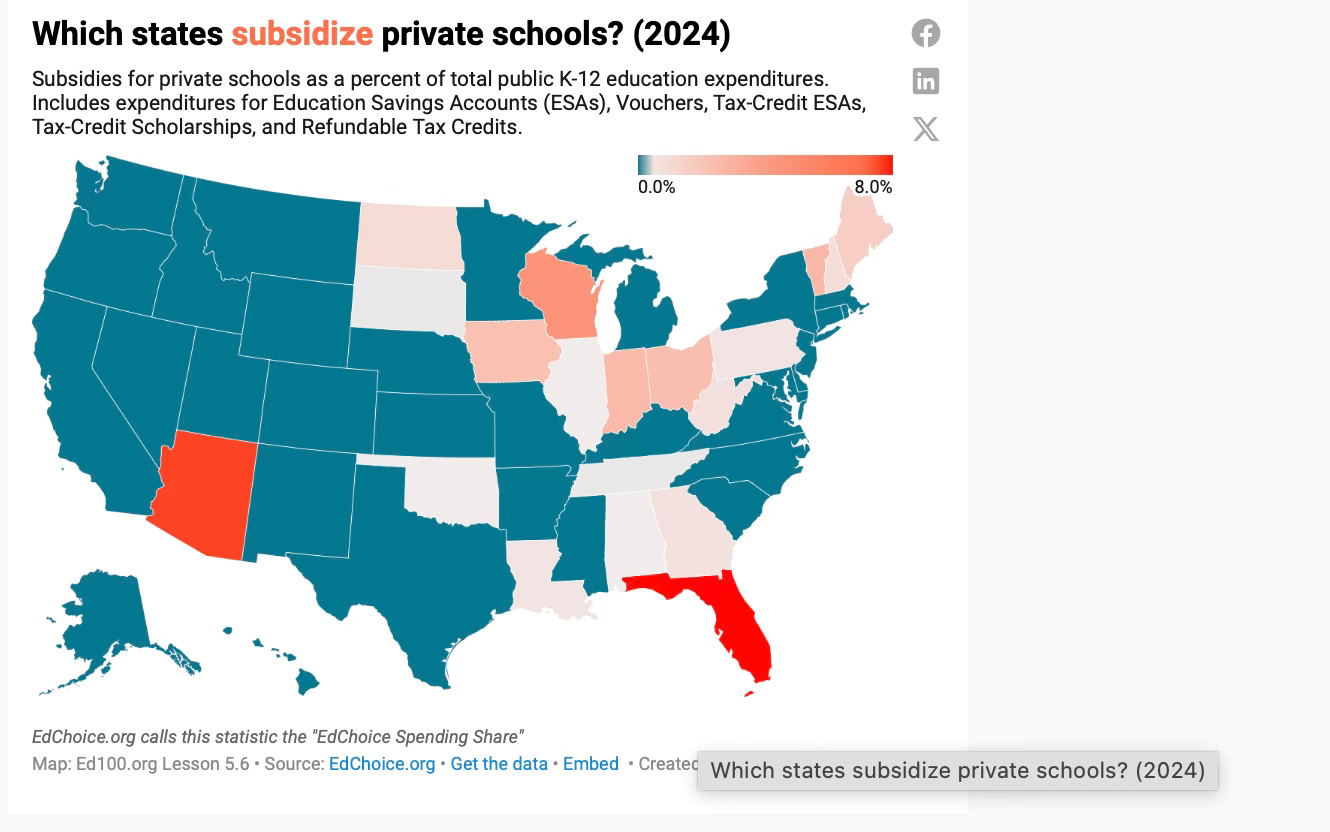Should your taxes pay for private and religious schools?
Most states, including California, currently require private schools to be privately funded, without subsidies from general taxes. President Trump proposes to upend this system, allowing federal money to support private and religious schools and pushing states to do the same. In California and many other states, Republicans have introduced bills that would divert funds from other uses to fund them.
These efforts raise basic questions about American values, particularly the separation of church and state. (About four out of five students in private schools attend a school associated with a religion.) This post examines the issues.
Federal “school choice” proposals
Trump executive order on “school choice”
Calling for “educational freedom and opportunity for families,” President Trump issued an expansive executive order on “school choice” in January 2025, under the theme that “parents, not the government, play a fundamental role in choosing and directing the upbringing and education of their children.”
The order was directed at multiple federal agencies. Let's take a look.
The Department of Education must issue guidance about how the States can use federal funding formulas to support K-12 scholarship programs. These programs typically provide a tax credit to someone who donates to a non-profit organization, such as a church, that provides scholarships for private and religious schools.
The Secretary of Education must prioritize school choice programs in the Department’s discretionary grant programs.
The Department of Health and Human Services must issue guidance on how states that receive block grants for children and families can use those funds to support educational alternatives, including private and faith-based options.
The Secretary of Defense must submit a plan to the President for how military families can use Department of Defense funds to send their children to the school of their choice.
The Secretary of the Interior must submit a plan to the President for how families with students attending Bureau of Indian Education schools can use federal funds to send their children to the school of their choice.
School choice legislation in Congress
Wait, wait, there’s more…
Two similar bills were proposed in Congress to change the federal tax code to give tax breaks to support church schools and other private schools. If passed, both the Education Freedom Scholarships and Opportunity Act and the Educational Choice for Children Act would allow tax credits for contributions to tax-exempt scholarship-granting organizations for elementary and secondary private and religious education expenses.
History of public money for private and religious schools
The first Amendment of the Constitution says:
“Congress shall make no law respecting an establishment of religion, or prohibiting the free exercise thereof.”
Thomas Jefferson famously described the intent of this amendment as a “wall of separation between church and state.”
In 1875, under the administration of President Ulysses S. Grant, James G. Blaine proposed a constitutional amendment to make clear that public funds could not be used to fund religious schools. Fueled in part by a wave of anti-Catholic sentiment, the Blaine Amendmentnearly became a part of the US constitution, but narrowly failed to secure support in enough states for ratification. Instead, the principle that the separation of church and state should apply to public education was separately adopted into most state constitutions, including California's.
School vouchers
In the context of education, vouchers are government-funded coupons good toward payment of tuition at private and religious schools.
In 1954, the Supreme Court ruled in Brown v. Board of Educationthat it is unconstitutional for districts to segregate students by race. The ruling triggered a wave of white flight to private schools, which were not subject to the desegregation order. To skirt the law, some southern states began issuing tax-funded tuition vouchers, which were accepted at private segregated schools.
The following year, in 1955, University of Chicago economist Milton Friedman developed an argument that diverted attention from the racist purposes of vouchers. Often referred to as the grandfather of the school choice movement, Friedman imagined a system that would make private education the norm rather than the exception. He reasoned in The Role of Government in Education that “universal vouchers for elementary and secondary schools would usher in an age of educational innovation and experimentation, not only widening the range of options for students and parents but increasing all sorts of positive outcomes.”
Over a period of decades, voucher systems have been tested and measured. In general, having a choice tends to be a good thing… with a catch. Researchers suggest that choice advocates also take seriously the impact of choice systems on the broader public purpose of education
Various tax policies can divert funds to private and religious education
Tax-funded voucher systems obviously divert public funds to private and church-affiliated schools. To make the diversion less obvious, proponents of school choice have stopped using the word voucher and instead devised mechanisms that achieve the same end result more subtly (and even more unfairly) by using the tax system.
Tuition tax deduction: The simplest of these policies is a tuition tax deduction, which allows taxpayers to reduce their taxable income by the amount they pay for private education costs. The result is that taxes subsidize part of the cost of private school tuition, especially benefiting wealthier taxpayers.
Tuition tax credit: A tax credit is an even more aggressively regressive tax policy — it counts money paid for tuition as if it were used to pay taxes. Again, deductions and tax credits are far more valuable to rich people than they are to those who pay very little taxes or none at all.
Tax credit scholarship: Under normal tax law, those who donate to non-profit organizations (including non-profit schools, PTAs, churches and others) can reduce their tax liability by deducting the amount from their taxable income. A tax credit scholarship system goes much farther. Essentially, it makes donating to religious schools or other private schools an alternative to paying taxes.
Education Savings Account (ESA): In an ESA system, states set aside money that parents can use to pay for non-public school education or services such as private tutoring, online programs, and extracurricular activities. According to the National Education Policy Center, these accounts are “designed to, among other things, work around state constitutional prohibitions preventing using public money to fund private schools, particularly religious schools.”
Who’s behind this movement?
Much of the demand for expanded voucher programs is coming from parents whose children already attend private schools. Obviously, these parents benefit directly when taxpayers pick up the tab!
Government support for private education is also a priority among White Christian nationalists and other extremists, because private schools are not bound by curriculum requirements and standards.
The movement to divert public funds to private religious education is funded by a group of wealthy conservatives including members of the DeVos, Koch, and Walton families, and leaders of the Bradley Foundation. For these advocates, the vision is to dismantle public education as we know it, redirecting the funds to subsidize church schools and other private schools to fill the void.
School choice does not require private school subsidies
Those who advocate for funding of private and religious schools aggressively use the term “school choice” to describe their intentions. It’s important to understand that these are separate issues. Offering families a choice of schools does not require undermining the separation of church and state or robbing from the poor to enrich the rich.
As we explain in Ed100 Lesson 5.5, California already has systems for school choice. About a tenth of students in this state attend charter schools, which are public schools governed separately from school districts. Districts have a lot of power over this matter, too. Some districts enforce locally-based attendance boundaries, which limit families’ school choices; others don’t. There are other policy options available that could expand these choices.
Opening the door for funding religious schools with taxes
In the Ed100 blog
Separation of church and state, shaken: Public funding for private schools.
California's voters have long opposed using taxes to fund private schools, rejecting initiatives in 1993, and again in 2000.
As part of a 2025 nationwide effort to direct funding to private and religious schools, some California legislators have proposed bills that would divert public money to them:
SB 64 Education expenses: School Choice Flex Account Act of 2025.
AB 19 Education expenses: Education Savings Accounts.
SCA-1 Educational expenses: School choice flex accounts and special education flex accounts. (2025-2026 proposed Constitutional amendment.)
Research about public money for private and religious schools
If we set aside concerns about separation of church and state, and we forgive the historical connection between vouchers and segregation, and we decide to be OK with the fact that voucher-like programs tend to subsidize private education for wealthier families at the expense of needier ones, what does research say about the impact on students? Are they better off?
The research mostly says no, no, no, and no. (Each “no” takes you to different research.)
Public subsidies for private and religious schools: Bad public policy
From the perspective of an individual student, sure — more options can be better than fewer options. But it’s bad public policy for the federal government to push states to subsidize private education. Doing so enriches the rich, diminishes funding for public schools, sets up subsidies for particular religions, and undermines the system we rely on to give all students a fair shot.
This article is from ED100.org., a free online resources to help you understand the education system. Sign up. It’s free.









I don’t think that Congress will get rid of special education.
Your writing is thorough, Carol. Thank you.
One point that is often missed is the role public schools play in “special education” (students who need support to learn).
In my experience, the private schools do not offer special ed and send their students to the public schools, where they are required to offer, either full time or after school to all that request the free service.
The question is, if all families are given school vouchers , will the requirement of public schools offering free special education programs disappear?